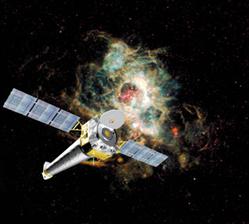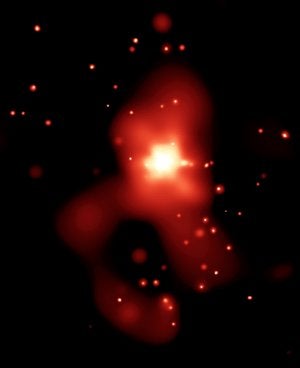The Chandra X-ray Observatory, which opened up a new world of X-ray astronomy and led to a new understanding of some of the universe’s most exotic and violent objects, marked its fifth year in service last week — and, astronomers say, its work may just be starting.
Launched from the space shuttle Columbia on July 23, 1999, the $1.5-billion NASA satellite has a sensitivity about 20 times greater than any previous X-ray telescope, allowing astronomers to probe the X-ray universe in as much detail as the Hubble Space Telescope allows in visible light. Chandra’s 64-hour-long orbit takes it 200 times higher than Hubble, carrying it one-third of the way to the Moon on every circuit.
Scientists revealed Chandra’s first results on August 26, 1999. Ever since, Chandra’s performance has been “spectacular,” making the craft “a super companion to Hubble,” says Chandra project scientist Martin Weisskopf of NASA’s Marshall Space Flight Center in Huntsville, Alabama. “I think it’s every bit as exciting and interesting as Hubble has been.”
X rays, like visible light, are a form of electromagnetic radiation; however, X-ray photons have much more energy than photons of visible light, and, therefore, are usually emitted by much hotter objects. So while ordinary stars emit most of their radiation at visible wavelengths, highly energetic objects like quasars and active galaxies shine like celestial beacons at X-ray wavelengths.
“It takes high energies to produce X rays, and so the physics behind the processes is usually more violent and therefore more interesting,” says Weisskopf.
In the first year of operation, data from Chandra led to an astounding array of discoveries, including:
- the first clear images of X rays emitted by matter falling into the black hole at the center of the Milky Way;
- detailed images of X-ray emitting stars, including a region in the Orion Nebula containing 1,000 individual sources;
- a supernova in the Small Magellanic Cloud, a companion galaxy to the Milky Way, marked by an expanding cloud of gas and dust.
The image covers 237 x 290 arcseconds.
Many of Chandra’s most intriguing discoveries have involved black holes, especially so-called supermassive black holes that scientists now believe lurk in the cores of nearly every galaxy. In 2002, Chandra identified the first known “binary black hole” — a pair of supermassive black holes living side by side in the unusually bright galaxy NGC 6240. Two years earlier, Chandra detected what astronomers call the “X-ray background radiation” — the feeble glow of X rays from billions of light-years away, coming from every direction in the sky. Astronomers believe the X rays were emitted by supermassive black holes in the cores of extremely ancient galaxies.
Thanks to Chandra, the textbook on supermassive black holes is being completely rewritten, says Richard Mushotzky of the Goddard Space Flight Center in Greenbelt, Maryland. “What Chandra has shown is that there are many more [supermassive black holes], by roughly a factor of five to ten, than we had thought,” he says. “So Chandra has completely revolutionized that field.”
And because more giant black holes exist, Mushotzky explains, they must have played a more important role in galactic evolution than anyone previously imagined. “Chandra has told us there are a lot more black holes; that they’re putting out a lot more energy than we thought; that they’re being produced at different times and in different places than we had previously thought — and that this has important consequences for how the universe put itself together; for where, when, and how galaxies form.”
Chandra was designed for a 5-year mission, but the spacecraft’s managers say there’s no reason it can’t last another decade or more. Chandra’s only expendable item is the gas for its attitude-control jets, which allow the craft to adjust its orientation. Chandra, says Weisskopf, has “enough gas for 15 to 20 years” of service. Only worn-out parts and bad luck could end the mission. “We’re hoping to operate for five, maybe ten more years,” Weisskopf says.
Chandra was conceived as part of NASA’s Great Observatories program, which includes Hubble and the Spitzer Space Telescope, an infrared orbiting scope launched last year. Chandra is operated by astronomers at the Chandra X-ray Center at the Smithsonian Astrophysical Observatory in Cambridge, Massachusetts, and is managed by the Marshall Space Flight Center. The spacecraft is named for Indian-born astrophysicist Subrahmanyan Chandrasekhar, who died in 1995.











